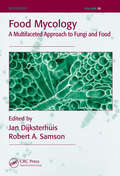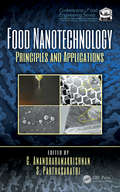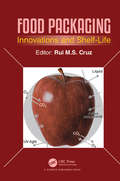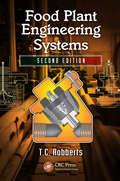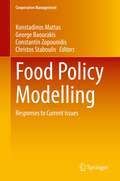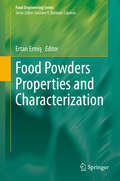- Table View
- List View
Food Manipulation Technology: A Soft Robotics Approach
by Shinichi Hirai Zhongkui WangWang and Hirai draw on their extensive experience to introduce recent technological advances in soft robotics for food manipulation and discuss their practical applications in the food preparation industry. They also describe food modeling and categorization for the purpose of robotic handling.Food manipulation is common in restaurants, kitchens, and food factories, but it currently largely relies on humans because of the lack of effective robotic systems. This book therefore explains recent manipulation technology for food handling and restaurant/kitchen automation, which is essential for food manipulation. The book covers the theoretical background of soft robotic hands; their application to different handling purposes in the food industry; their use in kitchen and restaurant automation; and their use for food recognition, property measuring, and modeling. The authors also present case studies of the development of soft robotic hands to illustrate the information and provide practical information that will be instructional for readers. Readers will gain an in-depth appreciation of the technology and its practical application to industry, which will enable them to implement this in their own work.This book is an essential read for both food technology practitioners and graduate students who are interested in food manipulation and its related technologies. It gives readers the theoretical background knowledge and practical understanding to apply this cutting-edge technology in real-world settings.
Food Microbial Sustainability: Integration of Food Production and Food Safety
by Arun Karnwal Abdel Rahman Mohammad Said Al-TawahaThis book reviews all important aspects of Microbial sustainability in food production and food safety with the aim of shedding new light on these microbes through combined understanding of traditional and novel paradigms. The book is divided into three sections, the first of which reinterprets fundamentals of food microbiology, examining the beneficial aspects of microorganisms in food and microbial responses from food environments and preservation. The second section discusses recent advances in understanding of the sustainable food production, covering, for example, agriculturally important microbes, farming microbes, and fermentation. A wide range of bio-factory issues in food production are also addressed, before turning attention to contemporary food safety approaches in the context of novel assessment methods for microbiological food characterization, improving food safety and food quality, etc. The final section is devoted to public health and its importance of microorganisms in food processing as well as the economic importance of microorganisms as this is also an increasingly important area as we move toward microbial research advances.
Food Microbiology Based Entrepreneurship: Making Money From Microbes
by Olubukola Oluranti Babalola Natarajan Amaresan Dhanasekaran DharumaduraiThis book is first part of the 3 volume set focusing on basic and advanced methods for using microbiology as an entrepreneurial venture. This book deals with the concept of entrepreneurship skills for production, cost-benefit analysis and marketing of button, oyster, milky mushroom, Ganoderma sp, Single cell protein, Breads, Cheese, Yoghurt, Wine, Beer, Probiotics, Prebiotics fermented vegetables, and Fermented Fish etc. Chapters cover the applications of microorganisms in small and large scale production to achieve a sustainable output. This book provides essential knowledge and working business protocols from all related disciplines of food and dairy industry, probiotics industry, mushroom industry, beverage and baking industry, poultry industry, and aquaculture industry etc. This book is useful to graduate students, research scholars and postdoctoral fellows, and teachers who belong to different disciplines via botany, food microbiology, biotechnology, aquaculture microbiology and poultry microbiology. The other two volumes are focused on agriculture and industrial microbiology.
Food Microbiology Laboratory for the Food Science Student: A Practical Approach
by Cangliang Shen Yifan ZhangThis book is designed to give students an understanding of the role of microorganisms in food processing and preservation; the relation of microorganisms to food spoilage, foodborne illness, and intoxication; general food processing and quality control; the role of microorganisms in health promotion; and federal food processing regulations. The listed laboratory exercises are aimed to provide a hands-on-opportunity for the student to practice and observe the principles of food microbiology. Students will be able to familiarize themselves with the techniques used to research, regulate, prevent, and control the microorganisms in food and understand the function of beneficial microorganism during food manufacturing process. The second edition add 5 new chapters including “Chapter 10 -Thermal inactivation of Escherichia coli O157:H7 in mechanically tenderized beef steaks and color measurements”, “Chapter 11-Evaluate antimicrobial activity of chlorine water on apples and measurement of free chlorine concentrations”, “Chapter 12-Evaluate cross-contamination of Salmonella on tomatoes in wash water using most probable number (MPN) technique”, “Chapter 15-DNA extraction and purity determination of foodborne pathogens”, and “Chapter 16-Practice of multiplex PCR to identify bacteria in bacterial solutions”. It also includes new lab work flowcharts for Gram-staining and endospore-staining technology in Chapter 1, pour plating and spread plating in Chapter 3, Enterotube II in Chapter 9, and Kirby Beau test procedure in Chapter 20. It includes a new sample of syllabus with the hybrid teaching of both lecture and lab sections in one course, which will assist junior faculty/instructors to develop similar lecture and lab courses.
Food Microbiology Protocols
by John F. Spencer Alicia L. Ragout de SpencerExpert laboratorians present a wide ranging set of detailed techniques for investigating the nature, products, and extent of the microorganisms involved in the manufacture and spoilage of foodstuff. The methods cover pathogenic organisms that cause spoilage, microorganisms in fermented foods, and microorganisms producing metabolites that affect the flavor or nutritive value of foods. Included in the section dealing with fermented foods are procedures for the maintenance of lactic acid bacteria, the isolation of plasmid and genomic DNA from species Lactobacillus, and the determination of proteolytic activity of lactic acid bacteria. A substantial number of chapters are devoted to yeasts, their use in food and beverage production, and techniques for improving industrially important strains. Comprehensive and timely, Food Microbiology Protocols is a gold-standard collection of readily reproducible techniques essential for the study of the wide variety of microorganisms involved in food production, quality, storage, and preservation today.
Food Microbiology: An Introduction
by Thomas J. Montville Karl R. Matthews Kalmia E. KnielThis textbook presents authoritative coverage in a format designed to facilitate teaching and learning. Encourages students to venture beyond memorization and think critically to gain a broader conceptual understanding of food microbiology and acquire the understanding and skills necessary to ensure the safety of tomorrow's food supply. Introduces the genetics and molecular mechanisms important for the understanding of foodborne microbes. Includes expert perspectives on parasites, viruses and prions, and non-thermal processes. Incorporates instructors' input to further clarify complex topics in the field of food microbiology. Presents explicit learning goals to focus students on the core principles of food microbiology.
Food Microbiology: An Introduction (ASM Books)
by Karl R. Matthews Kalmia E. Kniel Faith J. CritzerLeading textbook presenting all aspects of food microbiology Food Microbiology: An Introduction presents the basics of microorganisms that impact food safety and quality, the roles of beneficial microbes, food safety regulations, and proper practices for safe and healthy foods throughout all aspects of the supply chain. This Fifth Edition has been updated to reflect advances in research and technology and threats to the global food supply while retaining the pedagogy and structure that students and professors appreciate. Written in a clear and easy-to-understand style, the book is divided into four sections: Part I introduces the fundamentals of food microbiology, including a brief history of the field, the growth processes of food microorganisms, the biology of spores and sporeformers, techniques for enumeration and detection of organisms in food, description of rapid and automated microbial methods, and a new chapter focused on antimicrobial resistance. Part II addresses important regulatory issues and focuses on foodborne pathogenic microorganisms with chapters describing the most common bacterial species that cause foodborne diseases, as well as discussion of parasites, viruses, and prions. Part III explores nonpathogenic microbes important in food, including those responsible for fermentations and food spoilage. Part IV focuses on the control of microorganisms in food, including chemical antimicrobials, biological and physical methods of food preservation, nonthermal processing, and food safety systems. Food Microbiology: An Introduction also includes updated information on: The growing threats of antimicrobial resistance and climate change and their potential impacts on the global food supplyUse of next-generation sequencing techniques in the identification of microbes in foodExpanded discussion on sanitizers, disinfectants, and nonthermal processing treatmentsUp-to-date information on the Food Safety Modernization Act, hazard analysis and critical control points, and good manufacturing practices Food Microbiology: An Introduction is an essential textbook for undergraduate and graduate students in food science, nutrition, and microbiology, providing the knowledge and tools necessary to navigate the complexities of food microbiology in the 21st century.
Food Microbiology: An Introduction (ASM Books)
by Thomas J. Montville Karl R. Matthews Kalmia E. KnielAuthoratative coverage presented in a format designed to facilitate teaching and learning.
Food Molecular Microbiology (Food Biology Series)
by Jayanta Kumar Patra Spiros ParamithiotisWith the advances in the field of molecular biology, new tools make it possible to conduct in-depth studies in food microbial communities from a molecular perspective. Information from genomic, transcriptomic, proteomic and metabolomic studies can be integrated through bioinformatic applications, thereby improving our understanding of the interactions between biotic and abiotic factors and concomitantly the physiology of starter cultures, spoilage and pathogenic microbiota. Improvements in the speed, accuracy and reliability of food quality and safety assessment have made the foundation stronger for future developments including the exploitation of gene networks and applications of nanotechnology and systems biology. This book reviews all these developments, provides an integrated view of the subject and helps in identifying areas of future development.
Food Mycology: A Multifaceted Approach to Fungi and Food (Mycology)
by Robert A. Samson Jan DijksterhuisFor millennia, the presence of fungi in food has been both boon and bane to food stores. Fungi can spoil large quantities of food and produce dangerous toxins that threaten human health; however, fungal spoilage in certain foods can produce a unique, highly prized food source and there are some very effective fungal derived medicines. A thorough un
Food Nanotechnology: Principles and Applications (Contemporary Food Engineering)
by C. Anandharamakrishnan S. ParthasarathiNanotechnology offers great potential to revolutionize conventional food science and the food industry. The use of nanotechnology in the food industry promises improved taste, flavor, color, texture, and consistency of foodstuffs and increased absorption and bioavailability of nutraceuticals. Food Nanotechnology: Principles and Applications examines the current state of nanoscale phenomena and processes, benefits and risks of nanotechnology. This work contains 18 chapters particularly focused on the design, production, and utilization of nanoparticles, with specific applications for the food industry. Through several studies, it has been proven that nanotechnology can offer distinct advantages over conventional methods in terms of functionality, targeted delivery of food bioactive compounds, improved food quality characteristics like texture, taste, sensory attributes and improved stability in the gastrointestinal tract, and controlled release profiles. Features Offers clear and concise coverage on application of nanotechnology in nutrient delivery, food packaging, and pathogen/pesticide detection Addresses both the technological aspects of delivering nano-based food products and the societal implications that affect take-up Covers broad range of topics including nanoemulsification, electrospraying, nanocomposites, plasma processing, and nanosensors Discusses different formulation and preparation methods for loading food bioactive compounds Exploratory in nature, this book presents the latest of such data on all aspects of applications of nanotechnology in food systems. With its practical focus on the fabrication and application of nanotechnology in food, this book is a valuable resource for students, researchers, food process engineers.
Food Network Magazine The Big, Fun Kids Baking Book Free 14-Recipe Sampler!
by Food Network Magazine Maile CarpenterCalling all junior bakers! Check out this special selection of 14 recipes from the first-ever baking book for kids from the editors of Food Network Magazine—including Carrot-Coconut Muffins,Lemon-Raspberry Quick Bread, Peanut Butter Cup Brownies, Butterscotch Blondies, Snack-Attack Cookies with Bacon and S&’mores Cake. Then if you want more, look for all 110 recipes in The Big, Fun Kids Baking Book. It also includes food trivia, tips, food crafts, and other fun activities.
Food Network Magazine The Big, Fun Kids Baking Book: 110+ Recipes for Young Bakers (Food Network Magazine's Kids Cookbooks #2)
by Food Network Magazine Maile CarpenterThe ultimate kids' cookbook for beginner bakers, from the editors of America's #1 food magazine and bestselling authors of The Big, Fun Kids Cookbook.This collection is packed with tons of recipes for easy sweets and treats, designed with young cooks in mind and triple tested by the chefs in Food Network Kitchen. Kids will get all the info they need to make their favorite desserts: muffins and quick breads, brownies and bars, cookies, cupcakes, sheet cakes, and more. The recipes are simple to follow and totally foolproof, and each one comes with a color photo and pro tips to help junior chefs get started in the kitchen. Inside you'll find: • 110+ delicious recipes • Fun food trivia • A visual recipe index with a photo of every recipe • Choose-your-own adventure recipes (such as design-your-own Whoopie Pies and Banana Bread) • Crowd-pleasers like Red Velvet Brownies, Pumpkin Spice Chocolate Chip Cookies, Mini PB & Chocolate Cupcakes, Chocolate Candy Bar Layer Cake, and more! • Fun food crafts such as cookie puzzle pieces and DIY sprinkles • Amazing fake-out cakes including spaghetti and meatballs, a taco, and a pineapple • Bonus food-themed activity pages with word scrambles, spot-the-difference photo games, and more • Lay-flat binding and a heavy paper stock that will stand up to frequent use
Food Nutrition, Science and Technology
by Neelam Singh I. S. SinghThis book explores the nexus of science, technology and nutrition that shapes the way we produce, consume and experience food. It discusses the innovations and principles driving the future of nourishment. The latest scientific information on food nutrition, science and technology are compiled for a better understanding of each division. Print edition not for sale in South Asia (India, Sri Lanka, Nepal, Bangladesh, Pakistan and Bhutan)
Food Packaging: Advanced Materials, Technologies, and Innovations
by Sanjay Mavinkere Rangappa, Jyotishkumar Parameswaranpillai, Senthil Muthu Kumar Thiagamani, Senthilkumar Krishnasamy and Suchart SiengchinFood Packaging: Advanced Materials, Technologies, and Innovations is a one-stop reference for packaging materials researchers working across various industries. With chapters written by leading international researchers from industry, academia, government, and private research institutions, this book offers a broad view of important developments in food packaging. Presents an extensive survey of food packaging materials and modern technologies Demonstrates the potential of various materials for use in demanding applications Discusses the use of polymers, composites, nanotechnology, hybrid materials, coatings, wood-based, and other materials in packaging Describes biodegradable packaging, antimicrobial studies, and environmental issues related to packaging materials Offers current status, trends, opportunities, and future directions Aimed at advanced students, research scholars, and professionals in food packaging development, this application-oriented book will help expand the reader’s knowledge of advanced materials and their use of innovation in food packaging.
Food Packaging: Innovations and Shelf-Life
by Rui M. S. Da CruzFood Packaging: Innovations and Shelf-life covers recently investigated developments in food packaging and their influence in food quality preservation, shelf-life extension, and simulation techniques. Additionally, the book discusses the environmental impact and sustainable solutions of food packaging. This book is divided into seven chapters, written by worldwide experts. The book is an ideal reference source for university students, food engineers and researchers from R&D laboratories working in the area of food science and technology. Professionals from institutions related to food packaging.
Food Packaging: Materials,Techniques and Environmental Issues (Lecture Notes in Management and Industrial Engineering)
by Anup K. Ghosh N. C. Saha Meenakshi Garg Susmita Dey SadhuThis comprehensive and authoritative book aims to encompass the best and current practices in the field of contemporary food packaging. It covers various aspects of packaging, including challenges and their solutions, innovations, and environmental concerns. Written by experts working in the field, the content is supported by technical/statistical data, practical examples, case studies, and real-life experiences of academicians and professionals working in the area of food packaging. The book covers challenges in food packaging, systems and materials for packaging, packaging design requirements of the food industry, technology machinery and system, printing and graphics, testing and regulatory aspects, advanced and smart packaging, distribution and logistics in a globalized environment, and sustainable and green packaging. This book will be useful for Packaging Technologists, food scientists, material scientists, policy makers, students, and researchers.
Food Packaging: The Smarter Way
by Ashutosh Kumar ShuklaThis book reviews the science and technology of food packaging and covers the potential innovations in the food packaging sector. At the same time, it highlights the issues and prospects for linking the laboratory research to the market. In addition to typical packaging requirements such as food quality, shelf life, protection, communication, and marketing, the book emphasizes the need for novel packaging materials, including biodegradable packaging for a variety of food products. A wide range of food products has been kept in focus and includes animal-based food products such as dairy products and sea foods. The book presents the next level of packaging solutions i.e., smart packaging with the applications of potential tools such as intelligent and active packaging, and includes the latest research on emerging digital technologies for packaging development, assessment, and acceptability. It further highlights the strategies including blends, reinforcing agents, cold plasma, UV light applications, chemical, and enzymatic methods and explores the new opportunities leading to improvement in the packaging performance. Smart freshness indicator applications, including gas and time-temperature indicators for quality and safety of packaged products, have been covered in detail. The book also includes the functional characteristics of edible films and coatings, including their bioactive characteristics. Finally the book presents the rules and regulation related to packaging.
Food Physics: Physical Properties - Measurement and Applications
by Arthur A. Teixeira Ludger O. FiguraThis is the first textbook in this field of increasing importance for the food and cosmetics industries. It is indispensable for future students of food technology and food chemistry as well as for engineers, technologists and technicians in the food industries. It describes the principles of food physics starting with the very basics – and focuses on the needs of practitioners without omitting important basic principles. It will be indispensable for future students of food technology and food chemistry as well as for engineers, technologists and technicians in the food industries. Food Physics deals with the physical properties of food, food ingredients and their measurement.
Food Phytates
by N. Rukma Reddy Shridhar K. SatheFood Phytates takes a new look at phytates, including their potential health benefits. It includes the latest information on the beneficial heath effects of phytates, the influence of phytates in disease prevention, the potential use of phytate as an antioxidant in foods, and phytase expression in transgenic plants. In 14 chapters, leading research
Food Plant Engineering Systems
by Theunis Christoffel RobbertsThe component parts of a manufacturing system are important. Without peripherals and services such as pumps, boilers, power transmission, water treatment, waste disposal, and efficient lighting, the system will collapse. Food Plant Engineering Systems, Second Edition fills the need for a reference dealing with the bits and pieces that keep systems
Food Plants of the Sonoran Desert
by Wendy C. HodgsonThe seemingly inhospitable Sonoran Desert has provided sustenance to indigenous peoples for centuries. Although it is to all appearances a land bereft of useful plants, fully one-fifth of the desert's flora are edible. This volume presents information on nearly 540 edible plants used by people of more than fifty traditional cultures of the Sonoran Desert and peripheral areas. Drawing on thirty years of research, Wendy Hodgson has synthesized the widely scattered literature and added her own experiences to create an exhaustive catalog of desert plants and their many and varied uses. Food Plants of the Sonoran Desert includes not only plants such as gourds and legumes but also unexpected food sources such as palms, lilies, and cattails, all of which provided nutrition to desert peoples. Each species entry lists recorded names and describes indigenous uses, which often include nonfood therapeutic and commodity applications. The agave, for example, is cited for its use as food and for alcoholic and nonalcoholic beverages, syrup, fiber, cordage, clothing, sandals, nets, blankets, lances, fire hearths, musical instruments, hedgerows, soap, and medicine, and for ceremonial purposes. The agave entry includes information on harvesting, roasting, and consumption-and on distinguishing between edible and inedible varieties. No other source provides such a vast amount of information on traditional plant uses for this region. Written to be easily accessible to general readers, the book is an invaluable compendium for anyone interested in the desert's hidden bounty.
Food Policy Modelling: Responses to Current Issues (Cooperative Management)
by Constantin Zopounidis Konstadinos Mattas George Baourakis Christos StaboulisIn the present economic, political, societal and environmental landscape, which is dominated by the COVID-19 pandemic, the emergence of challenges and issues that demand immediate and urgent responses is more intense than ever. Policymakers, international organizations, governmental and non-governmental institutions around the globe are seeking effective and sustainable policies, as they try to tackle far-reaching issues that affect all aspects of the economy and agriculture, including the food sector. In this context, this book presents new modelling approaches and their application to complex problems in the agro-food chain in order to address today’s pressing food policy issues. The respective chapters showcase national and regional studies on sustainable communities, rural environments and ecosystems. Taken together, they offer a valuable reference guide for scholars and practitioners alike.”
Food Powders Properties and Characterization (Food Engineering Series)
by Ertan ErmişFood powders are an increasingly important aspect of processed food worldwide. Essential factors such as ease of storage and transport and usage convenience have greatly benefited the food industry and promise further advancements in processing techniques. Food powders can be stored for a longer period of time than other food products, making them essential for food supply in many regions of the world. There have been numerous research works on food powders properties and characterization, but there has not been an updated comprehensive review in this field. Food Powders Properties and Characterization is designed as an essential reference for individuals in the food industry and academia seeking a singular source that covers most of the basic aspects of food powders. With chapters focusing on the general properties of food powders, characterization of particle and bulk properties, adhesion and surface properties, this text presents comprehensive and fully up to date coverage of this challenging and important field.
Food Printing: 3D Printing in Food Industry
by Sunpreet Singh Kamalpreet SandhuThis book provides a comprehensive overview of the technical notes, research designs, literature, and 3DP (three-dimensional printing) technology applications for effective food printing. It provides a multidisciplinary coverage of 3D food printing in different food sectors. Recent advancements in manufacturing processes have led food industries to create innovations to stay competitive in the market. 3D food printing incorporates 3DP digital gastronomy strategies to manufacture food products with consistency in shape, color, flavor, texture, and even nutrition. Thus, by controlling the number of materials and the quality of nutrients, food items can be manufactured and handled to fulfill their particular requirements. For food printing, both proprietary structures and self-developed frameworks are used from open sources. Similar frameworks are re-engineered to reformulate administration, content creation, and user interface. For example, three printing medium types, natural printable products, non-printable synthetic food products, and alternative ingredients as well as two recipe forms (i.e., element-based recipes and regular recipes) are used for customized food production. The authors address that open 3D technology for food printing and food processing technology are theoretically correlated with food printing. The book will help industrial designers, nutrition professionals, dieticians, manufacturing enterprises, and young researchers in food technology, material science, and mechanical engineering understand the latest advances in 3DP technology in food industries.









